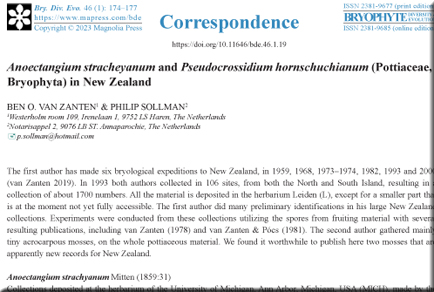Abstract
The first author has made six bryological expeditions to New Zealand, in 1959, 1968, 1973–1974, 1982, 1993 and 2000 (van Zanten 2019). In 1993 both authors collected in 106 sites, from both the North and South Island, resulting in a collection of about 1700 numbers. All the material is deposited in the herbarium Leiden (L), except for a smaller part that is at the moment not yet fully accessible. The first author did many preliminary identifications in his large New Zealand collections. Experiments were conducted from these collections utilizing the spores from fruiting material with several resulting publications, including van Zanten (1978) and van Zanten & Pócs (1981). The second author gathered mainly tiny acrocarpous mosses, on the whole pottiaceous material. We found it worthwhile to publish here two mosses that are apparently new records for New Zealand.
Downloads
References
- Bridel, S.E. (1826) Bryologia universa 1. Leipzig.
- Cano, M.J. & Jiménez, J.A. (2013) A taxonomic revision of the tribe Pleuroweisiae (Pottiaceae, Bryophyta) in South America. Phytotaxa 143 (1): 1–42. https://doi.org/10.11646/phytotaxa.143.1.1
- Cano, M.J., Jiménez, J.A., Ochyra, R. & Guerra, J. (2023) Weissia balansae (Müll. Hal.) R.H. Zander (Bryophyta) and new or otherwise interesting records of Pottiaceae for sub-Saharan Africa. Nova Hedwigia 116 (1–2): 1–21. https://doi.org/10.1127/nova_hedwigia/2023/0733
- Catcheside, D.G. (1980) The Mosses of South Australia. Government Printer, Adelaide, 364 pp.
- Chen, P.C. (1941) Studien über die Ostasiatischen Arten der Pottiaceae I-II. Hedwigia 80: 1–76, 141–322.
- Dixon, H.N. (1913–29) Studies in the Bryology of New Zealand, with special reference to the herbarium of Robert Brown, of Christchurch, New Zealand. New Zealand Institute Bulletin 3 (1–6): 1–372. https://doi.org/10.5962/bhl.title.57893
- Fife, A.J. (1995) Checklist of the mosses of New Zealand. The Bryologist 98: 313–337. https://doi.org/10.2307/3243371
- Gibb, E.S., Wilton, A.D., Schönberger, I., Fife, A.J., Glenny, D.S., Beever, J.E., Boardman, K.F., Breitwieser, I., Pauw, B. de, Ford, K.A., Greer, P.A., Heenan, P.B., Korver, M.A., Maule, H.G., Novis, P.M., Prebble, J.M., Smissen, R.D. & Tawiri, K. (2021) Checklist of the New Zealand Flora – Hornworts, Liverworts and Mosses. Lincoln, Manaaki Whenua-Landcare Research. http://dx.doi.org/10.26065/yhf2-dv02
- Hedwig, J. (1801) Species Muscorum Frondosorum. Leipzig and Paris. 325 pp.
- Hornschuch, C.F. [1822] (1824–1828) Sylloge Plantarum Novarum 2 vols. Regensburg.
- Ignatova, E.A. (2009) The genus Anoectangium (Pottiaceae, Bryophyta) in Russia. Arctoa 18: 167–176. https://doi.org/10.15298/arctoa.18.10
- Jiménez, J.A., Cano. M.J. & Guerra, J. 2022 [2021] A multilocus phylogeny of the moss genus Didymodon and allied genera (Pottiaceae): Generic delimitations and their implications for systematics. Journal of Systematics and Evolution 60 (2): 281–304. https://doi.org/10.1111/jse.12735
- Landwehr, J. (1984) Nieuwe atlas Nederlandse bladmossen. Thieme, Zutphen, 568 pp.
- Li, X.J. & Iwatsuki, Z. (1997) Revision of the genus Anoectangium from China. Acta Botanica Yunnanica 91: 243–250.
- Lüth, M. (2019) Mosses of Europe – A Photographic Flora. Set of 3 Volumes. Published by the author. Freiburg, Germany, 1353 pp.
- Mitten, W. (1859) Musci Indiae Orientalis, an enumeration of the mosses of East Indies. Journal of the Proceedings of the Linnean Society, Botany, Supplement 1: 96.
- Müller, F. (2009) An updated checklist of the mosses of Chile. Archive for Bryology 58: 1–124.
- Smith, A.J.E. (2006) The Moss Flora of Britain and Ireland, second edition. Cambridge University Press, U.K., 1012 pp.
- Sollman, P. & Koponen, T. (2020) A collection of Pottiaceae (Bryophyta) from Sichuan and Yunnan, China, with contributions to other families. Acta bryolichenologica Asiatica 9: 167–202.
- Sollman, P. (2023a) Anoectangium strachyanum (Bryophyta: Pottiaceae) in Europe. Nova Hedwigia vol. 116 (1–2): 39–44. https://doi.org/10.1127/nova_hedwigia/2023/0727
- Sollman, P. (2023b) Remarks on several pottiaceous mosses mainly from the Australian continent. Hattoria 14: 17–25. https://doi.org/10.18968/hattoria.14.0_17
- Taylor, T. (1846) The distinctive characters of some new species of Musci, collected by Professor William Jameson, in the vicinity of Quito, and by Mr. James Drummond at Swan River. London Journal Botany 5: 41–67.
- Zander, R.H. (1979) Notes on Barbula and Pseudocrossidium (Bryopsida) in North America and an annotated key to the taxa, Phytologia 44: 177–214. https://biostor.org/reference/63643
- Zander, R.H. (2019) Macroevolutionary evaluation methods extended, consolidated and exemplified with Anoectangium (Pottiaceae, Bryophyta) in North America and the Himalayas. Annals Missouri Botanical Garden 104: 324–338. https://doi.org/10.3417/2019332
- Zander, R.H. & Eckel, P.M. (2007) Anoectangium. In: Flora North America Editorial Committee (Org.) Flora of North America, North of Mexico, Vol. 27. Bryophyta Part 1. pp. 520–523.
- Van Zanten, B.O. (1978) Experimental studies on transoceanic longrange dispersal of moss spores in the Southern Hemisphere. Journal of the Hattori Botanical Laboratory 44: 455–482.
- Van Zanten, B.O. (2019) Op Mossenjacht in tropisch Azië en Australazië tussen 1959 en 2000. Drukkerij Hoekstra, St. Annaparochie, 335 pp. [Note: an English version is available at the address of the first author.]
- Van Zanten, B.O. & Pócs, T. (1981) Distribution and dispersal of bryophytes. Advances of Bryology 1: 479–562.

